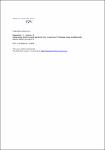Harnessing prions as test agents for the development of broad-range disinfectants
Wagenführ, Katja
Beekes, Michael
The development of disinfectants with broad-range efficacy against bacteria, viruses, fungi, protozoa and prions constitutes an ongoing challenge. Prions, the causative agents of transmissible spongiform encephalopathies (TSEs) such as Creutzfeldt-Jakob disease (CJD) or its variant (vCJD) rank among the pathogens with the highest resistance to disinfection. Pilot studies have shown that different procedures devised for prion disinfection were also highly effective against microbial pathogens. This fueled the idea to systematically exploit prions as test pathogens for the identification of new potential broad-range disinfectants. Prions essentially consist of misfolded, aggregated prion protein (PrP) and putatively replicate by nucleation-dependent, or seeded PrP polymerization. Recently, we have been able to establish PrP seeding activity as a quantitative in vitro indicator for the disinfection of 263K scrapie prions on steel wires used as surrogates for medical instruments. The seeding activity on wires re-processed in different disinfectants could be (1) biochemically determined by quantitative protein misfolding cyclic amplification (qPMCA), (2) biologically detected after qPMCA in a cell assay and (3) correctly translated into residual titers of scrapie infectivity. Our approach will substantially facilitate the identification of disinfectants with efficacy against prions as promising candidates for a further microbiological validation of broad-range activity.
No license information

